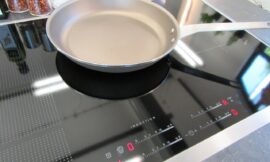Induction stoves have revolutionized the way we cook, offering fast heating, precise temperature control, and energy efficiency. But have you ever wondered how these sleek and modern appliances actually work? In this article, we will delve into the fascinating inner workings of an induction stove and explore the science behind its operation.
The Science of Induction Heating:
At the heart of an induction stove lies a remarkable technology known as induction heating. Unlike traditional electric or gas stoves that rely on direct heat transfer, induction stoves utilize electromagnetic fields to generate heat within the cookware itself.
The Key Components:
An induction stove consists of several key components that work together to create this innovative cooking method. These components include:
- Induction Coil: Located beneath the glass-ceramic cooktop, the induction coil is made of copper wire and is responsible for producing the electromagnetic fields. When an electric current passes through the coil, it generates a rapidly alternating magnetic field.
- Ferromagnetic Cookware: To effectively utilize induction heating, the cookware must be made of a ferromagnetic material such as cast iron or stainless steel. These materials contain magnetic properties that allow them to respond to the alternating magnetic field generated by the induction coil.
- Control Circuitry: The control circuitry in an induction stove regulates the power supplied to the induction coil, enabling precise temperature control and other features such as power levels and timers.
The Induction Heating Process:
When an induction stove is turned on and a compatible cookware is placed on the cooking zone, the following process occurs:
- Magnetic Field Generation: As electricity flows through the induction coil, it creates a rapidly alternating magnetic field around it.
- Induced Electric Current: When the ferromagnetic cookware is brought into the magnetic field, the alternating magnetic field induces an electric current within the cookware. This phenomenon is known as electromagnetic induction.
- Resistive Heating: The induced electric current flows through the ferromagnetic material, encountering resistance. According to Joule’s law, this resistance results in the conversion of electrical energy into heat energy. As a result, the cookware itself begins to heat up.
- Heat Transfer: The generated heat within the cookware is then transferred to the food or liquid inside, resulting in the cooking process. The heat is precisely and rapidly controlled by adjusting the power supplied to the induction coil.
Benefits of Induction Cooking:
The induction cooking method offers numerous advantages over traditional cooking methods:
- Efficiency: Induction stoves are highly energy-efficient since the heat is generated directly in the cookware, minimizing heat loss and reducing cooking times.
- Precision and Control: Induction stoves provide precise temperature control, allowing for rapid adjustments and accurate cooking results.
- Fast Heating: The electromagnetic induction process ensures quick and efficient heating, reducing preheating times significantly.
- Safety: Induction stoves are generally safer to use as the stovetop itself remains relatively cool during cooking, reducing the risk of burns. Additionally, many induction stoves come equipped with safety features such as automatic shut-off and child lock functions.




